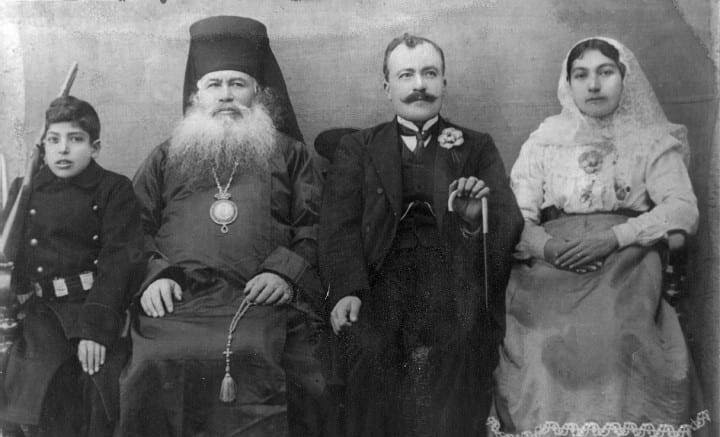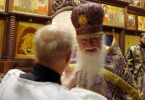Bishop Elia of Supurgansk and Urmia passed away on this day in 1928.
The Byzantine Empire had its own geopolitical Grand Strategy, which contained a mixture of military, diplomatic and missionary methods aiming at protecting the empire from outsiders. However, the mission was often conducted by holy people, like Sts Cyrill and Methodios, for whom Slavs were Christian souls and not lesser people than Byzantines. In a similar fashion, while missions of various Christian countries in the nineteenth and twentieth centuries promoted their faith within the Ottoman Empire, there were those who truly cared for their flock, like the future St. Cyril, Metropolitan of Kazan, who was a missionary in Urmia (modern day Iraq) from 1902 until 1904. My deceased associate at ROCOR Studies, Michael Woerl (+2019), wrote the following account on the Assyrian bishop Mar Elia from this province, which I am circulating here in an abbreviated form.
* * *
Mar (Bishop) Elia (Abraham, Avraham, Awraham, Oraham) was born to a Nestorian Assyrian family in the village of Armutagash in Urmia province (Persian Azerbaijan) in 1858 (some sources claim 1856). The episcopate in the Nestorian church was hereditary, passed down from uncle to nephew, those eligible proclaimed “Natar Kursi” (“Nazarites”) from birth. The Nestorians traced down their origin from the heretical Archbishop Nestorios of Constaninople, who rejected the name Theotokos for the Mother of God. In 1875, the Nestorian hierarch Mar Gabriel converted to Orthodoxy, and was accepted as a Bishop. In 1896, Mar Gabriel “during his trip to Kurdistan from Persia, was brutally murdered on the Persian-Turkish border, and with him were killed 14 people who formed his retinue.”
The future Mar Elia graduated from the American Mission School in Urmia and learned English there. The American Mission was founded by the Presbyterian Minister Justin Perkins, “the first citizen of the United States to reside in Iran [Persia].” Mar Elia was also sent to the United States to study. He began his studies at the General Theological Seminary in New York City in May, 1894, graduating in 1896. Trustees’ minutes and the student magazine, The Seminarian, refer to him as a “special student” who was a “Deacon from Oroomiah” (Urmia). One source dates Mar Elia’s ordination as Deacon to 1896; the comments in the General Theological Seminary’s student magazine, that he was a “Deacon from Oromiah,” place it in 1894 or before.
A large group of Nestorians converted to Orthodoxy in 1898, led by their bishop, Mar Jonah (Yonan in Assyrian) of Supurgansk. The services to receive Mar Jonah and his clergy into the Orthodox Church were held on the Feast of the Annunciation at St. Alexander Nevsky Lavra in St. Petersburg with Metropolitan Pallady (Pavel Ivanovich Pisarev-Raev, June 20, 1875–December 5, 1898) of Moscow officiating. The day after Mar Jonah and his clergy were accepted into the Orthodox Church (26 Mar 1858), the Holy Synod of the Russian Orthodx Church instituted the Russian Ecclesiastical Mission in Urmia. The purpose of the Mission was to aid the flock of Mar Jonah in Urmia in their transition to Orthodoxy. Many other difficulties were faced … the Western Missions in Urmia were rich, and well established. Eventually the Mission accomplished a great deal, but there were missteps early on; some clergy assigned to the Mission, proving themselves not up to the task, variously faced dismissal, defrocking, or simply quit.
After his reception into the Orthodox Church, Mar Elia remained in Russia until 1903, auditing courses at the St. Petersburg and Kiev Theological Academies in 1898 and 1899 respectively.
The years 1904 to 1910 were difficult for the Orthodox in Urmia. Russia’s defeat by Japan, and the unrest in Russia that followed, caused a loss of respect for Russian power, and the Muslims took advantage of this situation. World War I created further havoc for the Orthodox in Urmia. They first faced persecution by the Kurds in 1914. Cossack units and Assyrians prevented the Kurds from entering Persia, but an attack on Persia by Ottoman troops in late December 1915 resulted in a secret order for Russian troops to evacuate Urmia and make their way to Russian territory. The retreating Russians, accompanied by Mission staff, were followed by several thousands of Orthodox Assyrians, ill-equipped for travel, and suffering much along the route, leaving “thousands of Christians in Urmia under the threat of complete destruction by fanatical Muslims.”
In October 1914, the Ottoman Empire began deporting and massacring Assyrians and Armenians in Van. The 1915 Fatwa of the Sheikh-ul-Islam (highest Islamic authority in the Ottoman Empire, confirmed by the Sultan) brought this “Holy War” to Urmia. Entire Assyrian villages were destroyed. Assyrians were ordered to renounce Christ, or die, and there were cases of martyrdom.
Mar Elia was not hanged, as reported, but had been tortured. He had to be ransomed from the Muslims for a “huge” price. Later in 1915, Mar Elia travelled to Moscow, where he lived in a monastery. In 1916, he was bestowed with the Order of Saint Vladimir, Third Degree. He returned to Urmia in March 1917.
In late 1918, due to yet more persecution at the hands of the Muslims, over 100,000 Christians fled Urmia towards Iraq, where there were British forces. Many were killed or perished from disease and starvation on the road. Mar Elia accompanied the refugees through Hamadan, to Tabriz, in Persia. He returned to Urmia in 1920. In 1921, unable to communicate with Patriarch Tikhon in Moscow, Mar Elia contacted the Synod of the Russian Orthodox Church Outside of Russia, and his diocese joined the ROCOR. Known as a great preacher, Mar Elia spent the remainder of his earthly life with his flock, and reposed in the Lord on November 1, 1928 (other sources claim December 1928) in the city of Urmia. He was buried in the Mat Mariam Orthodox Church in Urmia. Memory Eternal!
Sources:
Michael Woerl, “Abun Mar Elia (Abraham, d. November 1928) of Supurgansk and Urmia,” Historical Studies of the Russian Church Abroad.











